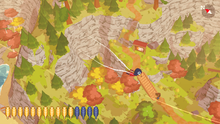Animals in video games
The depiction of animals in video games has echoed the wider symbolism of
Use as NPCs

Realistic-seeming animals in a video game world are seen as critical for building player immersion and a very important part of worldbuilding, as a lack of them can cause the level to appear dull and lifeless. This becomes even more important when the game is set in a natural environment. However, concessions are made to preserve a game's story and gameplay. For example, animals cannot be too skilled at hiding themselves or the player will have difficulty hunting them successfully, and they are typically restricted from entering certain places where they may disrupt important story moments.[1]
Some people believe that different animals are held to different standards of coverage. Mark Delaney from GameSpot questioned the "wholesomeness" of
The 2019 creation of Can You Pet the Dog?, a Twitter account listing whether dogs or other creatures can be pet, sparked an accompanying Internet meme of the same name, and a movement to add greater interactivity to in-game animals. The meme resulted in some game designers adding petting mechanics, sometimes at the expense of other elements of the game.[4] In particular, the lack of dog-petting seen in The Legend of Zelda: Breath of the Wild prompted a large response from the community, causing IGN to do an interview with the game's director on why they cannot be petted.[5]
Use as companions

One of the most common uses of animal companions in games is the concept of a mount, a
In recent years, games began exploring the idea of animal autonomy, rather than simply having the player expect mindless obedience, reflecting evolving real-world views on animal rights. Examples include The Last Guardian (2016), in which Trico, an enormous griffin-like creature, may disobey the player and show "stubbornness". In The Legend of Zelda: Breath of the Wild (2017), unlike earlier games in the series, horses must be bonded with in order to unlock the ability to customize them or use them to their full potential.[6]
Use as protagonists

Historically, most games featuring animals as protagonists anthropomorphized them with human-like behavior and speech, with Crash Bandicoot and Sonic the Hedgehog being famous examples.[9] The stories of such games typically play out like those of human characters. A shapeshifting main character can allow for a compromise between human and animal gameplay, as shown in such games as The Legend of Zelda: Twilight Princess (2006) or Divinity II (2009).
Some games feature animals with realistic appearances but unrealistic behavior. A lot of them feature dogs or cats as the main character, but other animals get starring roles as well. These animals include deer, wolves, sharks, and foxes. Examples of this type of animal game include Goat Simulator and Catlateral Damage.[9]
However, a smaller group of games feature animals that exhibit relatively realistic behavior, including Stray (2022), a post-apocalyptic game about a cat that becomes lost in an abandoned city. These games often require significant attention to detail so that players are fully immersed.[1]
References
- ^ a b Mercante, Alyssa (2022-06-28). "From Ghost of Tsushima to Stray, here's how devs design the most realistic in-game animals". gamesradar. Archived from the original on 2023-05-10. Retrieved 2023-05-11.
- ^ a b Delaney, Mark (29 July 2022). "Wholesome Games Are Awkwardly Comfortable Depicting Violence Against Animals". GameSpot. Archived from the original on 22 July 2023. Retrieved 22 July 2023.
- ^ Hartup, Andy (11 October 2013). "The 11 cutest animals we've hunted in video games". GamesRadar. Archived from the original on 22 July 2023. Retrieved 22 July 2023.
- ^ Stoeber, Jenna (2020-10-29). "Every game needs a pet-the-dog mechanic". Polygon. Retrieved 2023-05-11.
- ^ Goldfarb, Andrew (9 December 2017). "Zelda: Breath of the Wild Director Explains Why You Can't Pet the Dogs". IGN. Archived from the original on 11 May 2023. Retrieved 11 May 2023.
- ^ a b Joho, Jess (2017-05-17). "Video games are creating smarter animals". Polygon. Archived from the original on 2023-05-06. Retrieved 2023-05-11.
- ^ Mercante, Allysa. "The ten best video game animal companions". GamesRadar. Archived from the original on 2021-10-10. Retrieved 2023-05-15.
- from the original on 2023-05-11. Retrieved 2023-05-11.
- ^ a b Faber, Tom. "How animals in gaming went from cartoon characters to real creatures". Financial Times. Archived from the original on 2023-05-10. Retrieved 2023-05-15.
